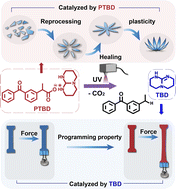On-demand catalyst-regulated distinctive topological transformations in a dynamic covalent network†
Abstract
Topological transformations in typical dynamic covalent polymer networks do not alter the network architectures, but offer unique adaptabilities including self-healing, reprocessing, and shape reconfigurability. In contrast, topology isomerizable networks allow changing network topologies, leading to programmable physical properties. Combining the two transformation mechanisms into one network would greatly extend the material versatility, but achieving this goal is challenging due to a mechanistic contradiction. We report our successful effort with a dynamic covalent network for which the bond exchange kinetics is regulated by an on-demand catalyst. The network consists of a polycaprolactone backbone, pendant hydroxyls, and a switchable catalyst. The weak alkalinity of the catalyst promotes slow transesterification in polycaprolactone domains, leading to a topological transformation suitable for thermal healing, reprocessing, and shape reconfiguration without changing the polymer properties. Upon UV activation, the catalyst becomes a strong base which induces significant network isomerization due to the rapid transesterification between hydroxyls and polycaprolactone, changing the polymers from crystalline to amorphous. Further spatio-temporal control of the switchable catalyst allows selective programming of both the shapes and properties, which offers potential benefits for emerging applications including flexible electronics and soft robotics.



 Please wait while we load your content...
Please wait while we load your content...